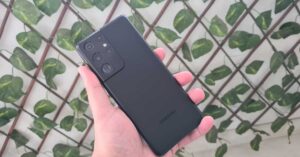Samsung Galaxy S21 Ultra
The Samsung Galaxy S21 Ultra has a 6.8-inch Edge QHD+ Dynamic AMOLED 2X Infinity-O Display with a resolution of 1,4403,200 pixels. HDR10+ is supported, as well as a 120Hz adaptive refresh rate. This phone, like its siblings, runs One UI on top of Android 11. There’s an octa-core Exynos 2100 SoC under the hood, along with up to 16GB LPDDR5 RAM and 512GB of storage.
The phone has a quad-camera setup on the back, which includes a 108-megapixel primary sensor with f/1.8 aperture and OIS support. A 12-megapixel Dual Pixel sensor with an f/2.2 aperture, a 10-megapixel telephoto lens with an f/2.4 aperture and 3x optical zoom, and a 10-megapixel telephoto lens with an f/4.9 aperture, OIS support, and 10x optical zoom round out the package. The phone also has a second laser autofocus sensor, and the camera setup supports 100X Space Zoom. A 40-megapixel selfie camera with an f/2.2 aperture is located on the front.
Vivo X70 Pro Plus
The Vivo X70 Pro Plus has a 6.78-inch ultra HD AMOLED display with a 120Hz refresh rate. The Qualcomm Snapdragon 888+ SoC is at the heart of the device, along with an Adreno 660 GPU.
A 48MP Sony IMX578 ultra-wide-angle sensor, a 50MP primary sensor, a 12MP portrait, and an 8MP periscope lens will make up the X70 Pro+’s quad-camera setup. The selfie camera is unchanged, but there is a 5,000mAh battery with fast charging support of 55W Flash Charge and 50W Wireless Flash Charge.
iPhone 13 Pro Max
The iPhone 13 Pro Max has a 6.68-inch Super Retina XDR display with ProMotion, which has an adaptive refresh rate of up to 120Hz, allowing for a faster and more responsive touch experience. An A15 Bionic chipset with 5-nanometer technology powers the devices, which features a new 6-core CPU with two new high-performance cores and four new high-efficiency cores. It has a new 5-core GPU that provides the fastest graphics performance, making it ideal for video apps, high-performance gaming, and a variety of new camera features.
The device has a triple rear camera setup, which is a highlight in terms of cameras. A 12-megapixel ultra-wide shooter, a 12-megapixel wide-angle lens, a 12-megapixel telephoto lens, and a LiDAR scanner are all included.
Mi 11 Ultra
The Mi 11 Ultra features a quad-curved 6.81-inch 2K WQHD+ E4 AMOLED display with a resolution of 3,200 1,440 pixels and HDR10+ support. The display panel supports a refresh rate of 120Hz and a touch sampling rate of 240Hz. A secondary display on the back is a 1.1-inch AMOLED touch screen with a resolution of 126294 pixels. Mi 11 Ultra is powered by Qualcomm Snapdragon 888 SoC with Adreno 660 GPU and runs MIUI 12 on top of Android 11. It comes with up to 12GB of LPDDR5 RAM and 256GB of UFS 3.1 storage.
The Xiaomi Mi 11 Ultra has a rectangular-shaped triple rear camera setup with a multi-functional secondary display for notifications, battery level, and weather alerts, which is the phone’s biggest highlight. A 50-megapixel Samsung GN2 primary wide-angle sensor with f/1.95 aperture and OIS support is included in the camera setup. There are two 48-megapixel Sony IMX586 ultra-wide-angle and tele-macro sensors onboard as well (5x optical and 120x digital zoom). All three sensors can record 8K video at 24 frames per second. A 20-megapixel sensor is located on the front of the device for selfies and video calls.
OnePlus 9 Pro
The OnePlus 9 Pro comes with a slew of impressive features. It has a 6.7-inch QHD+ AMOLED LTPO Fluid Display 2.0 screen for the display. The refresh rate varies depending on the type of content, ranging from 1 Hz to 120 Hz.
The device runs Android 11 with Oxygen OS 11 and is powered by Qualcomm Snapdragon 888 processor with 5G support. The phone’s Hasselblad-branded quad rear camera system, which includes the main camera, features a 48MP Sony IMX789 sensor and a 50-megapixel Sony IMX766 ultrawide sensor in terms of camera capabilities. A telephoto lens with an aperture of 8 megapixels and a 2-megapixel depth camera sensors are also included. A 16-megapixel sensor is available for selfies. The camera can shoot at a resolution of 8K at 30 frames per second (FPS). You can also shoot slow-motion video in 4K at 120 frames per second. For the latest gadget and tech news, and gadget reviews, follow us on Twitter, Facebook and Instagram. For newest tech & gadget videos subscribe to our YouTube Channel. You can also stay up to date using the Gadget Bridge Android App. You can find the latest car and bike news here.






